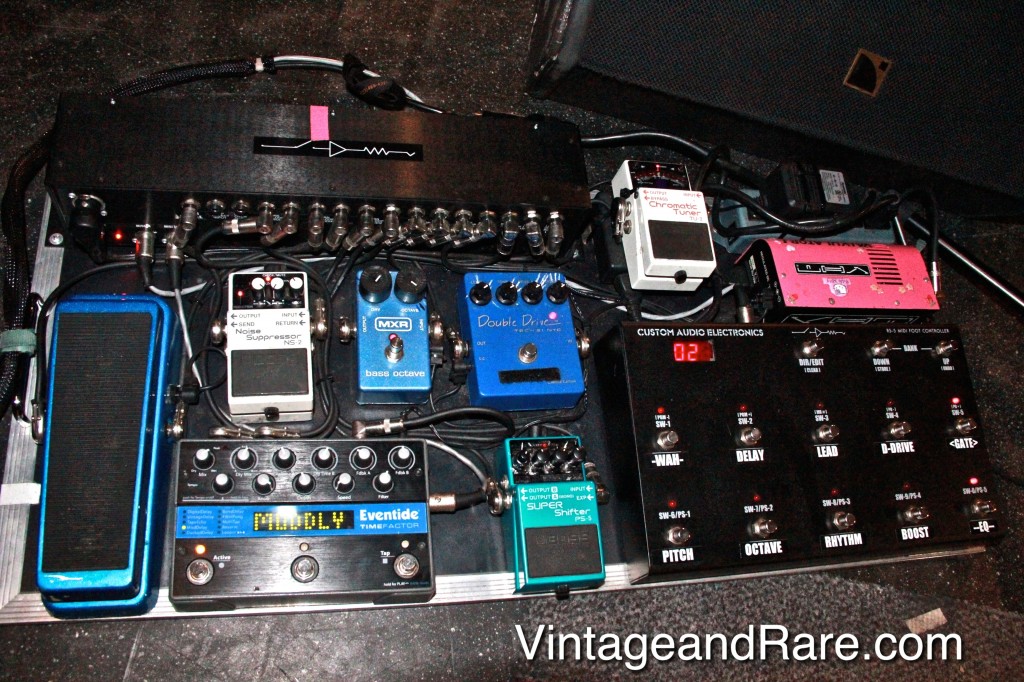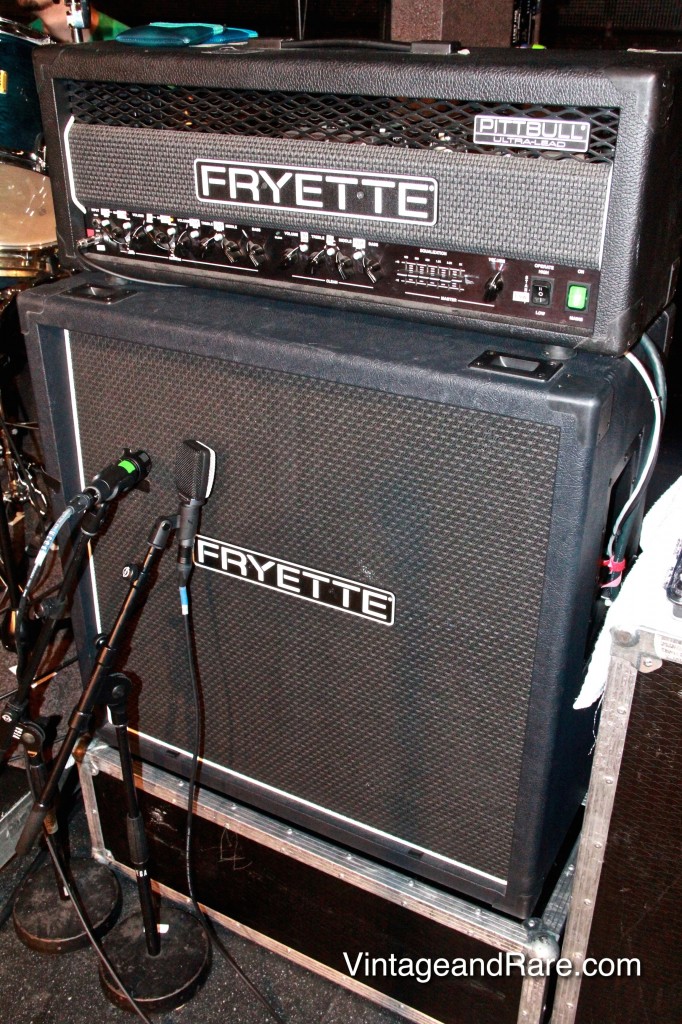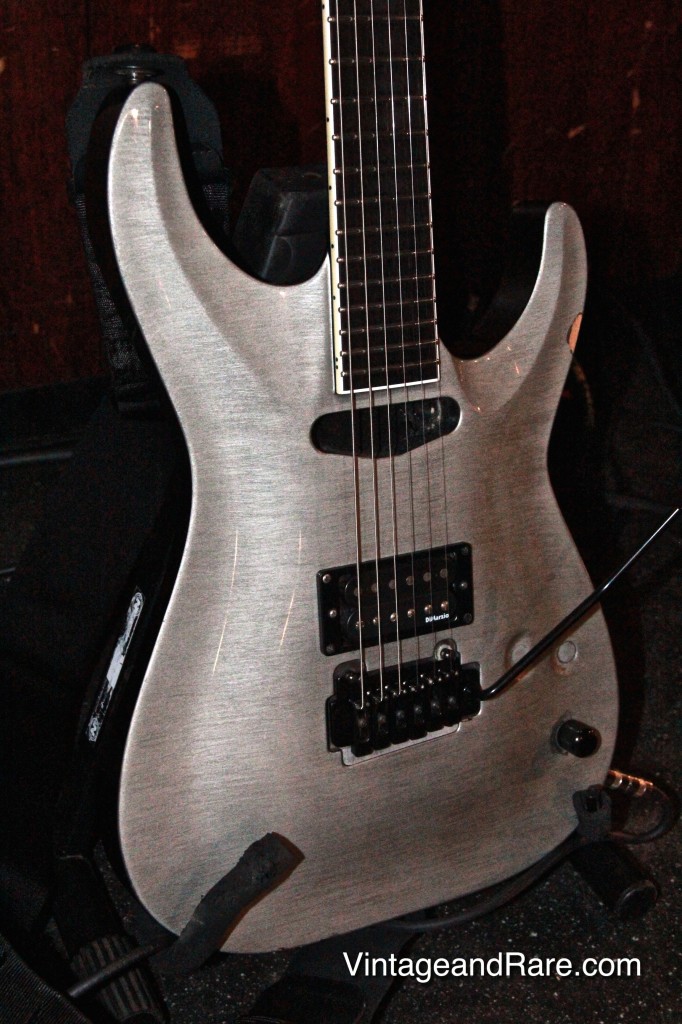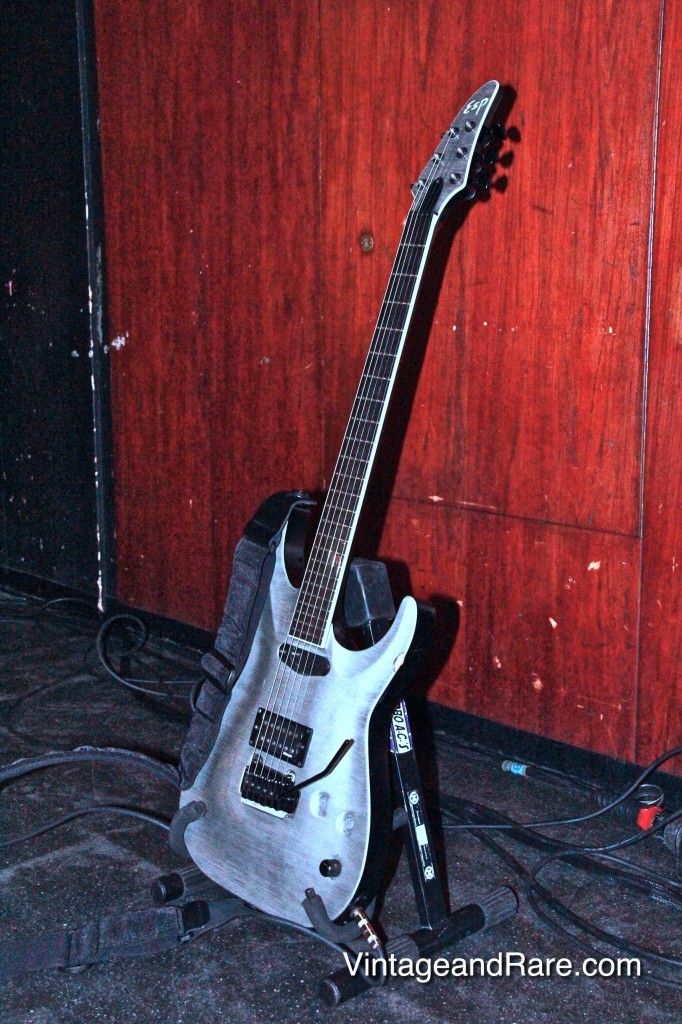Dating Fender Amps
1951-1967 – Tube chart on the inside of the amp is stamped with two letters (A – Q):
The first letter designates the year and the second letter designates the month.
A 1951 JAN
B 1952 FEB
C 1953 MAR
D 1954 APR
E 1955 MAY
F 1956 JUN
G 1957 JUL
H 1958 AUG
I 1959 SEP
J 1960 OCT
K 1961 NOV
L 1962 DEC
M 1963
N 1964
O 1965
P 1966
Q 1967
Mid ’70s – early ’80s – Amplifiers are dated much the same way as Fender guitars from the same era:
B + 5 digits 1975 – 1976
A6 + 5 digits 1976
A7 + 5 digits 1977
A8 + 5 digits 1978
A9 + 5 digits 1979
F0 + 5 digits 1980
F1 + 5 digits 1981
F2 + 5 digits 1982 – 1983
F3 + 5 digits 1983 – 1984
F4 + 5 digits 1984 – 1985
F9 + 5 digits 1979 – 1980
Dating Contemporary Fender Amplifiers
All Fender amplifiers manufactured from 1990 – present include a date code printed on the quality assurance (QA) sticker on the back of the amp chassis, and are dated the by the first letter as the year and the second letter as the month.
A 1990 JAN
B 1991 FEB
C 1992 MAR
D 1993 APR
E 1994 MAY
F 1995 JUN
G 1996 JUL
H 1997 AUG
I 1998 SEP
J 1999 OCT
K 2000 NOV
L 2001 DEC
M 2002
N 2003
O 2004
P 2005
ALL other Fender Amplifiers can be dated by the components inside:
In almost every Fender amplifier there are several EIA (manufacturer) codes followed by a date code, typically found on the speaker(s), transformer(s), tubes, caps, and occasionally pots. The EIA code will consist of 3 numbers followed by a date code of 3 or 4 numbers designating the year and the week. To give an example, a typical Oxford speaker from the ’60s will look something like: 465-217. 465 designating the Oxford EIA code, 2 designating the year 1962, and 17 designating the 17th week of ’62. Take a look at this ’62 Fender Princeton Amp, and you’ll see that exact speaker, as well as the typical Schumacher transformers (EIA 606) used in Fender amplifiers.
Serial Number ranges from amplifiers made between the late ’40s – late ’70s:
Bandmaster 5C7, 5D7 (tweed)
0001 to 0800 – 1953
5000 to 5500 – 1954
Bandmaster 5E7 (tweed)
S00001 to S00350 – 1955
S00350 to S01200 – 1956
S01100 to S01800 – 1957
S01700 to S02500 – 1958
S02500 to S03700 – 1959
Bandmaster 5G7, 6G7 (brown)
00001 to 0100 -1960
Bandmaster 6G7, 6G7-A (blonde)
00001 to 02400 – 1960
02300 to 05100 – 1961
49000 to 58000 – 1962
58000 to 59200 – 1963
Bandmaster AA763, AB763 (blackface)
A00001 to A01700 – 1963
A01400 to A08000 – 1964
A07700 to A17000 – 1965
A16000 to A22000 – 1966
A20000 to A27000 – 1967
Bandmaster AB763, AC568 (silverface)
A26000 to A29000 – 1967
A28000 to A34000 – 1968
A33000 to A34000 – 1969
A34000 to A45000 – 1970-72
Bandmaster Reverb AA768, AA1069, AA270, TFL5005 (silverface)
A31000 to A35000 – 1968
A35000 to A45000 – 1969
A45000 to A49000 – 1970
A48000 to A54000 – 1971
A54000 to A59000 – 1972
A59000 to A66000 – 1973
A66000 to A77000 – 1974
A75000 to A78000 – 1975
A78000 to A80000 – 1976
Bassman 5B6 (tweed)
0001 to 0300 – 1951
0300 to 0400 – 1952
0400 to 0600 – 1953
Bassman 5D6, 5D6-A (tweed)
0600 to 0900 – 1954
Bassman 5E6, 5E6-A (tweed)
0100 to 0200 – 1955
BM00001 to BM00550 – 1955
BM00550 to BM01200 – 1956
BM01200 to BM01600 – 1957
Bassman 5F6, 5F6-A (tweed)
BM00001 to BM00400 – 1957
BM00400 to BM01500 – 1958
BM01500 to BM03100 – 1959
BM03100 to BM04600 – 1960
Bassman 6G6, 6G6-A, 6G6-B (blonde)
BP00100 to BP01100 – 1961
BP01100 to BP05000 – 1962
BP05000 to BP08400 – 1963
BP08400 to BP12000 – 1964
Bassman AA864, AA165, AB165 (blackface)
A00100 to A03800 – 1964
A03800 to A15000 – 1965
A15000 to A25000 – 1966
A24000 to A33000 – 1967
Bassman AB165, AC568, AA270, AA371 (silverface)
A32000 to A40000 – 1967
A39000 to A49000 – 1968
A48000 to A58000 – 1969
A58000 to A60000 – 1970
Bronco AB764 (silverface)
A19000 to A21000 – 1967
A20000 to A26000 – 1968
A25000 to A28000 – 1969
A28000 to A29000 – 1970
A29000 to A32000 – 1971
A32000 to A35000 – 1972
A33000 to A39000 – 1973
A39000 to A42000 – 1974
A42000 to A51000 – 1975
Champion 800 (tweed)
01 to 1000 – 1948-49
Champion 600 5B1 (tweed)
01 to 1300 – 1948-49
1300 to 1700 – 1950
1700 to 5000 – 1951-52
5000 to 5500 – 1953
Champ 5C1, 5D1 (tweed)
5500 to 6600 – 1953
6600 to 8000 – 1954
8000 to 9999 – 1955
Champ 5E1, 5F1 (tweed)
C00001 to C00800 – 1955
C00800 to C03100 – 1956
C03100 to C06000 – 1957
C06000 to C08800 – 1958
C08800 to C12500 – 1959
C12500 to C15500 – 1960
C15500 to C16800 – 1961
C17000 to C19000 – 1962
C19000 to C21000 – 1963
C21000 to C23000 – 1964
Champ AA764 (blackface)
A00100 to A02000 – 1964
A01900 to A05200 – 1965
A05200 to A12000 – 1966
A12000 to A12200 – 1967
Champ AA764 (silverface)
A12200 to A13900 – 1968
A13900 to A18000 – 1969
A18000 to A30500 – 1970
A30500 to A32000 – 1971
A32000 to A35000 – 1972
A32000 to A42000 – 1973
A42000 to A50000 – 1974
A50000 to A63000 – 1975
A63000 to A85000 – 1976
Concert 5G12, 6G12, 6G12-A (brown)
00001 to 02400 – 1960
02300 to 05100 – 1961
49000 to 58000 – 1962
58000 to 59200 – 1963
Concert AA763, AB763 (blackface)
A00001 to A01700 – 1963
A01400 to A08000 – 1964
A07700 to A08800 – 1965
Model 26 Deluxe (woodie)
100 to 1500 – 1946-48
Deluxe 5A3, 5B3 (tweed)
001 to 800 – 1948
800 to 1900 – 1949
1900 to 3000 – 1950
3000 to 5400 – 1951
5400 to 6800 – 1952
6800 to 7300 – 1953
Deluxe 5C3, 5D3 (tweed)
0001 to 1500 – 1953
1500 to 3600 – 1954
3600 to 5300 – 1955
Deluxe 5E3 (tweed)
D00001 to D01400 – 1955
D01400 to D03000 – 1956
D03000 to D05000 – 1957
D05000 to D06800 – 1958
D06800 to D09000 – 1959
D09000 to D10000 – 1960
D10000 to D11000 – 1961
Deluxe 6G3, 6G3-A (brown)
D00100 to D00900 – 1961
D00800 to D03800 – 1962
D03800 to D04900 – 1963
Deluxe AA763, AB763 (blackface)
A00100 to A00500 – 1963
A00500 to A02800 – 1964
A02800 to A05600 – 1965
A05600 to A06100 – 1966
A06100 to A06500 – 1967
Deluxe Reverb AA763, AB763 (blackface)
A00100 to A00300 – 1963
A00300 to A03900 – 1964
A03900 to A13000 – 1965
A12000 to A19000 – 1966
A19000 to A24000 – 1967
Deluxe Reverb AB763, AB868 (silverface)
A24000 to A26000 – 1967
A26000 to A28500 – 1968
A28500 to A33000 – 1969
A31000 to A33000 – 1970
A33000 to A34500 – 1971
A34500 to A37000 – 1972
A37000 to A39000 – 1973
A39000 to A42000 – 1974
A42000 to A43000 – 1975
A43000 to A45000 – 1976
Dual Showman AA763, AB763 (blackface)
A00100 to A01400 – 1963
A01400 to A01700 – 1964
A01700 to A04300 – 1965
A04300 to A08000 – 1966
A07800 to A12000 – 1967
Dual Showman AB763, AC568 (silverface)
A12000 to A12500 – 1967
A12500 to A15000 – 1968
Dual Showman Reverb AA768, AA769, AA270, TFL5000 (silverface)
A13900 to A16500 – 1968
A16500 to A22400 – 1969
A21700 to A25600 – 1970
A25600 to A37000 – 1971
A37000 to A50500 – 1972
A50500 to A68000 – 1973
A68000 to A99999 – 1974
A81000 to A99999 – 1975
B01000 to B15000 – 1975
B15000 to B68000 – 1976
Harvard 5F10 (tweed)
H00100 to H00500 – 1956
H00500 to H01400 – 1957
H01400 to H02000 – 1958
H02000 to H02600 – 1959
H02600 to H03400 – 1960
H03400 to H03500 – 1961
Musicmaster Bass CFA-7010 (silverface)
A00100 to A04100 – 1972
A04100 to A07900 – 1973
A07900 to A09500 – 1974
A09500 to A09800 – 1975
A09800 to A10500 – 1976
Princeton 5B2, 5C2, 5D2 (tweed)
2500 to 3600 – 1953
3600 to 4400 – 1954
4400 to 4700 – 1955
Princeton 5F2, 5F2-A (tweed)
P0001 to P00350 – 1955
P0001 to P01100 – 1956
P01100 to P02400 – 1957
P02400 to P03000 – 1958
P03000 to P04300 – 1959
P04300 to P07000 – 1960
Princeton 6G2, 6G2-A (brown)
P00100 to P01000 – 1961
P01000 to P05100 – 1962
P05100 to P07200 – 1963
P07100 to P09900 – 1964
Princeton AA964 (blackface)
A00100 to A02500 – 1964
A02500 to A07000 – 1965
A05000 to A10400 – 1966
Princeton AA964 (silverface)
A10000 to A11000 – 1967-68
A11000 to A15000 – 1969-70
Princeton Reverb AA1164 (blackface)
A00100 to A02100 – 1964
A02100 to A07500 – 1965
A05500 to A14500 – 1966
A14000 to A18700 – 1967
Princeton Reverb AA1164, B1270 (silverface)
A18500 to A19500 – 1967
A18900 to A21500 – 1968
A21500 to A25500 – 1969
A24000 to A25000 – 1970
A25000 to A26000 – 1971
A26000 to A27500 – 1972
A27500 to A30000 – 1973
A30000 to A32500 – 1974
A32500 to A34500 – 1975
A34500 to A36000 – 1976
Pro 5A5, 5B5, 5C5, 5D5 (tweed)
01 to 600 – 1948
600 to 1100 – 1949
1100 to 1700 – 1950
1700 to 2500 – 1951
2500 to 3500 – 1952
3500 to 4800 – 1953
4500 to 6000 – 1954
Pro 5E5, 5E5-A, 5E5-B (tweed)
S00100 to S00800 – 1955
S00800 to S01200 – 1956
S01200 to S01800 – 1957
S01700 to S02500 – 1958
S02500 to S03700 – 1959
Pro 5G5, 6G5, 6G5-A (brown)
00001 to 02400 – 1960
02300 to 05100 – 1961
49000 to 58000 – 1962
58000 to 59200 – 1963
Pro AA763, AB763 (blackface)
A00001 to A01700 – 1963
A01400 to A08000 – 1964
Pro Reverb AA165 (blackface)
A00100 to A02700 – 1965
A02700 to A09200 – 1966
A07000 to A10200 – 1967
Pro Reverb AA1265, AB668, AA1069, AA270 (silverface)
A10000 to A10500 – 1967
A10500 to A12000 – 1968
A12000 to A13300 – 1969
A13400 to A14500 – 1970
A14500 to A15000 – 1971
A15000 to A15600 – 1972
A15600 to A17200 – 1973
A17200 to A19700 – 1974
A19700 to A20000 – 1975
A20000 to A21500 – 1976
Quad Reverb CFA7104 (silverface)
A33000 to A37000 – 1971
A37000 to A50500 – 1972
A50500 to A68000 – 1973
A68000 to A99999 – 1974
A81000 to A99999 – 1975
B01000 to B15000 – 1975
B15000 to B68000 – 1976
Reverb Unit 6G15 (brown, blonde, blackface)
R00100 to R00900 – 1961
R00900 to R02600 – 1962
R02600 to R04800 – 1963
R04800 to R07400 – 1964
R07400 to R09800 – 1965
R09800 to R11000 – 1966
Showman 6G14, 6G14-A (blonde)
00001 to 00350 – 1960
00200 to 00800 – 1961
00800 to 01500 – 1962
01500 to 01800 – 1963
Showman AA763, AB763 (blackface)
A00100 to A01400 – 1963
A01400 to A01700 – 1964
A01700 to A04300 – 1965
A04300 to A08000 – 1966
A07800 to A12000 – 1967
Showman AB763 (silverface)
A12000 to A12500 – 1967
A12500 to A15000 – 1968
Super incl. Dual Professional (tweed)
01 to 400 – 1946-47
500 to 1200 – 1949-51
2000 to 4300 – 1952-53
4500 to 5500 – 1954
5500 to 6100 – 1955
Super 5E4, 5F4 (tweed)
S00100 to S00800 – 1955
S00800 to S01200 – 1956
S01200 to S01800 – 1957
S01700 to S02500 – 1958
S02500 to S03700 – 1959
Super 5G4, 6G4, 6G4-A (brown)
00001 to 02400 – 1960
02300 to 05100 – 1961
49000 to 58000 – 1962
58000 to 59200 – 1963
Super Reverb AA763, AB763 (blackface)
A00100 to A00600 – 1963
A00600 to A06000 – 1964
A05900 to A13000 – 1965
A11000 to A20000 – 1966
A20000 to A27000 – 1967
Super Reverb AB763, AB568, AA1069, AA270 (silverface)
A26000 to A29000 – 1967
A27000 to A35000 – 1968
A35000 to A45000 – 1969
A45000 to A49000 – 1970
A48000 to A54000 – 1971
A54000 to A59000 – 1972
A59000 to A66000 – 1973
A66000 to A77000 – 1974
A75000 to A78000 – 1975
A78000 to A80000 – 1976
Super Six Reverb CFA7106 (silverface)
A33000 to A37000 – 1971
A37000 to A50500 – 1972
A50500 to A68000 – 1973
A68000 to A99999 – 1974
A81000 to A99999 – 1975
B01000 to B15000 – 1975
B15000 to B68000 – 1976
Tremolux 5E9, 5E9-A (tweed)
0001 to 00650 – 1955
00650 to 01000 – 1956
01000 to 01300 – 1957
01300 to 01700 – 1958
01700 to 02700 – 1959
02600 to 03300 – 1960
Tremolux 6G9, 6G9-A, 6G9-B (blonde)
00100 to 01000 – 1961
00900 to 04200 – 1962
04200 to 05900 – 1963
Tremolux AA763, AB763 (blackface)
A00100 to A00500 – 1963
A00500 to A03700 – 1964
A03200 to A05700 – 1965
A05200 to A08000 – 1966
Twin 5C8, 5D8, 5D8-A, 5E8, 5E8-A (tweed)
001 to 500 – 1953-55A00200 to A00725 – 1956-57
Twin 5F8, 5F8-A (tweed)
A00010 to A00725 – 1957-59
Twin 6G8, 6G8-A (blonde)
00001 to 00100 – 1960
00100 to 00225 – 1961
00225 to 00400 – 1962
00400 to 00525 – 1963
Twin Reverb AA763, AB763 (blackface)
A00100 to A01200 – 1964
A01200 to A04300 – 1965
A04300 to A07000 – 1966
A07000 to A10400 – 1967
Twin Reverb AB763, AC568, AA769, AA270 (silverface)
A10500 to A11300 – 1967
A10500 to A16500 – 1968
A16500 to A21400 – 1969
A21400 to A25600 – 1970
A25600 to A37000 – 1971
A37000 to A50500 – 1972
A50500 to A68000 – 1973
A68000 to A99999 – 1974
A81000 to A99999 – 1975
B01000 to B15000 – 1975
B15000 to B68000 – 19760100 to 3400 – 1970
Vibrasonic 6G13, 6G13-A (brown)
00001 to 00350 – 1960
00200 to 00800 – 1961
00800 to 01500 – 1962
01500 to 01800 – 1963
Vibro Champ AA764 (blackface)
A00100 to A02000 – 1964
A01200 to A08100 – 1965
A08100 to A16000 – 1966
A16000 to A20500 – 1967
Vibro Champ AA764 (silverface)
A19000 to A21000 – 1967
A20000 to A26000 – 1968
A25000 to A28000 – 1969
A28000 to A29000 – 1970
A29000 to A32000 – 1971
A32000 to A35000 – 1972
A33000 to A39000 – 1973
A39000 to A42000 – 1974
A42000 to A51000 – 1975
A51000 to A53000 – 1976
Vibrolux 5F11 (tweed)
F00001 to F00300 – 1956
F00300 to F00900 – 1957
F00900 to F01500 – 1958
F01500 to F02800 – 1959
F02800 to F04000 – 1960
F04100 to F04400 – 1961
Vibrolux 6G11, 6G11-A (brown)
00100 to 00700 – 1961
00700 to 03700 – 1962
03400 to 05500 – 1963
Vibrolux AA763 (blackface)
A00100 to A01300 – 1964
Vibrolux Reverb AA864 (blackface)
A00100 to A00800 – 1964
A00800 to A03600 – 1965
A03600 to A08300 – 1966
A08300 to A10700 – 1967
Vibrolux Reverb AA864, AA964, AB568, AA270 (silverface)
A10700 to A11000 – 1967
A11000 to A12000 – 1968
A12000 to A13700 – 1969
A13700 to A23400 – 1970
A23400 to A24500 – 1971
A24500 to A25000 – 1972
A25000 to A27000 – 1973
A27000 to A31500 – 1974
A31500 to A33000 – 1975
A33000 to A34000 – 1976
Vibrosonic Reverb (silverface)
A44000 to A50500 – 1972
A50500 to A68000 – 1973
A68000 to A99999 – 1974
A81000 to A99999 – 1975
B01000 to B15000 – 1975
B15000 to B68000 – 1976
Vibroverb 6G16 (brown)
00100 to 00600 – 1963
Vibroverb AA763, AB763 (blackface)
A00100 to A05300 – 1964
Typical Speakers found inside most Fender Amps:
Bandmaster 5C7, 5D7 (wide panel): Jensen P15N
Bandmaster 5E7, 6G7 (3×10): Jensen P10R, P10Q, Oxford 12K5R-1
Bandmaster 6G7-A: Oxford 12M6, Jensen C12N
Bandmaster AB763 and silverface: Oxford 12T6, Jensen C12N, Utah 12″
Bandmaster Reverb Silverface: Oxford, Utah 12″Bantam Bass Silverface: Yamaha trapezoidal
Bassman 5B6, 5C6: Jensen P15NBassman 5D6, 5E6-A, 5F6, 5F6-A: Jensen P10R, P10Q
Bassman 6G6 , 6G6-A, 6G6-B: Oxford 12M6; Jensen C12NBassman AA864, AA165: Oxford 12T6; Jensen C12N; Utah ceramic
Bassman Silverface: Oxford 12T6; Utah; Rola
Bassman Ten Silverface: CTS 10″ ceramic
Champ 5C1, 5D1: Cleveland 6″ alnico, Jensen P6T
Champ 5E1, 5F1: Oxford 8EV; Jensen P8T; CTS 8″ alnico
Champ AA764, silverface: Oxford 8EV
Concert 5G12, 6G12: Jensen P10R, P10Q
Concert 6G12-A: Jensen P10R, P10Q, C10R; Oxford 10K5
Concert AB763: Oxford 10K5, 10L5; Utah V10LXC1
Deluxe 5B3, 5C3, 5D3: Jensen P12R
Deluxe 5E3: Jensen P12R, P12Q
Deluxe 6G3, AB763: Oxford 12K5-6
Harvard 5F10, 6G10: Jensen P10R
Musicmaster Bass Silverface: CTS 12″ ceramic; Oxford 126PJ4
Quad Reverb Silverface: Oxford 12T6; Utah V12PC; Rola
Princeton 5C2, 5D2, 5F2, 5F2-A:Jensen P8T; Oxford 8EV; Cleveland 8″
Princeton 6G2, AA964: Oxford 10J4; Jensen C10R
Princeton Silverface: Oxford 10J4
Princeton Reverb AA1164: Oxford 10J4, 10L5; Jensen C10R, C10N
Princeton Reverb Silverface: Oxford 10J4; CTS
Pro 5A5: Jensen F15N (field coil), P15N
Pro 5B5, 5C5, 5D5: Jensen P15N
Pro 5E5, 5E5-A: Jensen P15N
Pro 6G5, 6G5-A: Jensen P15N; Oxford 15M6
Pro AB763: Jensen C15P; CTS 15″ ceramic
Pro Reverb AA165: Jensen C12N; Oxford 12L6
Pro Reverb Silverface: Oxford 12L6, 12T6; Utah, Rola 12″ ceramic
Showman 12 6G14, 6G14-A, AB763: JBL D120F with tone ring
Showman 6G14, 6G14-A, AB763: JBL D130F with tone ring
DualShowman AB763: JBL D130F
Dual Showman Rev Silverface: JBL D130F
Super 5B4, 5C4, 5D4, 5E4, 5E4-A: Jensen P10R
Super 5F4: Jensen P10R, P10Q
Super 6G4, 6G4-A: Jensen P10R, P10Q; Oxford 10K5
Super Reverb AA763, early AB763: Jensen C10R
Super Reverb AB763, silverface: CTS 10″ alnico or ceramic; Oxford 10L6; Rola 10″ ceramic
Super Six Reverb Silverface: Oxford 10L6; CTS 10″ alnico
Tremolux 5E9-A: Jensen P12R; P12Q
Tremolux 6G9, 6G9-A: Jensen P10Q or Oxford 10K5R w/tone ring
Tremolux 6G9-B: Oxford 10K5
Tremolux AB763: Oxford 10K5, 10L5; CTS 10″ ceramic
Twin 5C8, 5D8, 5E8-A: Jensen P12R; P12Q
Twin 5F8, 6G8: Jensen P12N
Twin 6G8, 6G8-A: Jensen P12N; Oxford 12M6
Twin Reverb AB763: Jensen C12N; Oxford 12T6
Twin Reverb Silverface: Oxford 12T6; EV; Gauss; Utah; Rola
Vibro Champ/Bronco: Oxford 8EV
Vibrolux 5E11, 5F11: Jensen P10R
Vibrolux 6G11, 6G11-A, AB763: Oxford 12L6, 12M6
Vibrolux Reverb AA864, AA964: Jensen C10Q; Oxford 10L5
Vibrolux Reverb Silverface: Oxford 10L5; CTS 10″ alnico
Vibrasonic 5G13, 6G13-A: JBL D130, D130F
Vibrosonic Reverb Silverface: JBL D130F, K130F; Gauss; EV
Vibroverb 6G16: Oxford 10K5
Vibroverb AA763, AB763: JBL D130F; Jensen C15N; CTS 15″ ceramic





